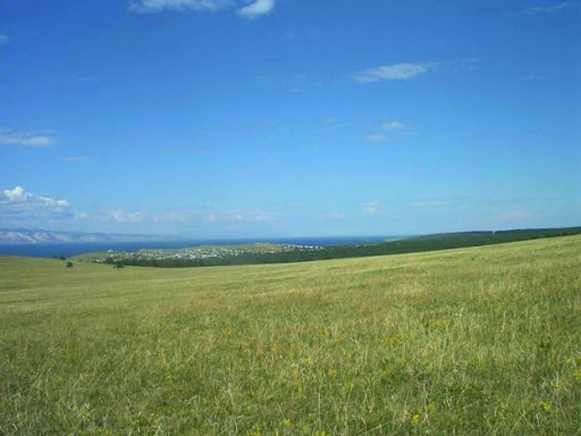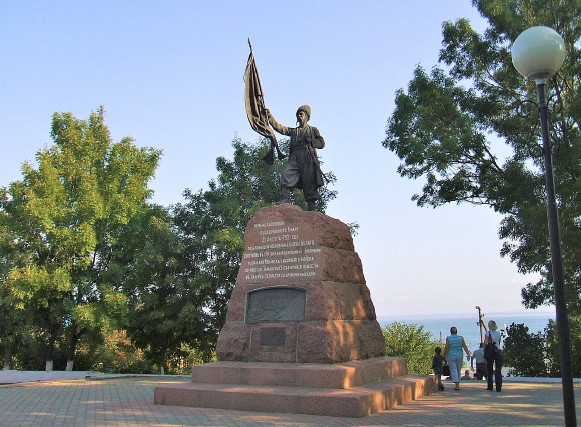Kuban
Kuban [Кубань; Kuban']. A historical-geographical region in northwestern Caucasia. Kuban is the southernmost Ukrainian ethnographic territory, separated from the rest of Ukraine by the Sea of Azov and the Russian Don region. It encompasses the western part of the steppes of Subcaucasia and the main massif of the Caucasus Mountains, their foothills, and their western slopes. Historically, in the west, Kuban was bordered by the Black Sea, the Sea of Azov and the Kerch Strait; in the north, by the Don region at the Yeia River; in the east, by the Stavropol region and the Terek region; and in the south, by Georgia and the main Caucasian Mountain range from Mount Elbrus to the Black Sea near Sochi. Kuban covers an area of about 100,000 sq km and has a population of approximately 5.8 million.
Until the end of the 18th century, ties between Kuban and the rest of Ukraine were weak because of the great distances separating the two. In the course of Russia’s struggle to control Caucasia and extend its influence into Asia Minor, Kuban, because of its location on the route to Baku, the Caspian Sea, and the warm water ports of the Black Sea (Novorossiisk), gained in significance. Kuban has great geopolitical importance for Ukraine. It strengthens its position on the Black Sea, cutting Russia off from it entirely, and provides a direct link to Transcaucasia.
Kuban emerged as a political and administrative unit in 1860 after the unification of the territories of the Black Sea Cossacks with the eastern regions of Kuban to create Kuban oblast. The new territory was mostly inhabited by the Kuban Cossack Host. In the 1860s the territory on the left bank of the Kuban River (the Transkuban) was joined to Kuban oblast. In 1896, the Black Sea coast was separated from the oblast to form the Black Sea gubernia. Most of the territory of Kuban was claimed after the First World War by the Kuban People's Republic, but in 1920 the region was incorporated by the Bolsheviks into the RSFSR as Kuban–Black Sea oblast. Reorganized several times in the 1920s, the territory of Kuban corresponds largely to the present-day Krasnodar krai (formed in 1937) and the Karachai-Cherkess Autonomous oblast on the upper reaches of the Kuban River, which was historically inhabited by Cherkessian (Circassian) tribes.
Geography. Kuban consists of several distinct geographic regions. The Kuban Lowland (up to 120 m in elevation) in the north is a poorly differentiated plain of fertile, chernozem-covered arable steppe. Its uniformity is only interrupted by occasional minor depressions. The southern region, on the left bank of the Kuban River, is called Transkuban (Zakubannia). It is more elevated and forested and broken by tributaries of the Kuban. A somewhat different relief is found on the Taman Peninsula, a part of the Kuban Lowland that separates the Sea of Azov from the Black Sea. It is covered by floodplains, and mud volcanoes are encountered. The Azov coast is characterized by widespread salt marshes and lagoons, and the Black Sea coast is distinguished by its clayey and sandy soils and Mediterranean climate and flora. In the east, the Kuban Lowland rises slightly to join the Stavropol Upland.
In the south, the Black Sea range of the Caucasus Mountains rises from the Kuban Lowland. Its elevation averages 300 m. The Vovchi Vorota and Hoitkh passes permit travel between the interior and the Black Sea coast. The Abkhaz and Central Caucasian ranges on the east are only partially situated on Kuban territory, and even less so on Ukrainian ethnographic territory. Asymmetrical spurs with steep southern and gentle northern slopes extend to the northeast. Two of these run parallel to the Black Sea range, and three run towards the east. The lower slopes of the mountains are covered by deciduous forests and the peaks are covered by coniferous forests and occasional alpine meadows. January temperatures average -5°C in northern and central Kuban and 5°C on the Black Sea coast, while July temperatures average 22–24°C. In the mountains, temperatures average -7 to -8°C in January and 12–13°C in July. Rainfall averages 400–600 mm in the lowlands and much higher in the mountains. The largest rivers are the Kuban River and its tributaries the Laba River, Urup River, and Bila River (Kuban), and the Protoka . Deposits of oil, natural gas, and rock salt are found there.
History
To the end of the 18th century. Kuban has been inhabitated without interruption since the Paleolithic Period. The region is rich in artifacts from the Neolithic Period and Bronze Age, especially the ‘Great Kuban graves,’ which contain the remains and riches of deceased chieftains. In the first half of the first millennium BC Kuban was one of the first centers of bronze making; from there the craft spread to Ukraine up to the Dnipro River. The first inhabitants were probably the Indo-European Cimmerians. In the 7th century BC they were pushed out by the Scythians. From that time, the region was populated by several interrelated peoples: the Scythians, the Sindians, who were centered south of the Kuban River and on the Taman Peninsula, and various Maeotian tribes on the shores of the Sea of Azov. They farmed and fished and conducted extensive trade with Byzantium. The Scythian culture flourished throughout Kuban, and many grave sites and artifacts have been excavated (see Scythian art). A number of Greek city-states (see Ancient states on the northern Black Sea coast), centered chiefly on the Taman Peninsula, were established in the 6th–5th centuries BC. The most important of these were Phanagoria, Hermonassa, and Cepi. These colonies, as well as the territories of the Sindians and Maeotians, were subsequently incorporated into the Bosporan Kingdom and the entire coastal region was largely Hellenized. After the 2nd century AD, the nomadic Sarmatians and Alans pushed the Scythian tribes out of the steppes. The invasion of the Huns in the 4th century AD destroyed the Bosporan Kingdom. The local inhabitants integrated with the Huns and other later invaders. In the west, the Maeotians and Sindians eventually became the Cherkessians (also known as the Circassians, they are the modern Adygeians and Kabardians), and in the central Caucasus Mountains, the Ossetes emerged from the Alans. In the 5th century some Goths came to the Taman Peninsula from the Crimea. In the 7th century, the entire Kuban region was incorporated into the Khazar kaganate. During this period, the Greek colonies on the Taman Peninsula and the Caucasian Black Sea coast remained as links to Byzantine culture and Christianity.
In the 9th century, colonies were established by the proto-Ukrainian Siverianians, who moved along the Donets River to the lower Don River, and from there to the shores of the Sea of Azov, the Taman Peninsula, and up the Kuban River. After Prince Sviatoslav I Ihorovych’s defeat of the Khazars, Ossetians (known in Rus’ sources as the Yasy), and Cherkessians (known as the Kasohy), the Tmutorokan principality of Kyivan Rus’ was established in Taman. It was under the control of the Chernihiv princes, and the Cherkessians were its vassals. In the 12th century, the Cumans cut Kuban off from the rest of Ukraine and ended Rus’ control over Tmutorokan. However, Rus’ settlements on the shores of the Sea of Azov were still mentioned in 13th-century chronicles as vassals of the Cumans.
In the first half of the 13th century, Kuban was conquered by the Mongols. Many local inhabitants sought refuge in the mountains (see Caucasian mountain peoples). When Mongol influence declined, several Italian (mainly Genoese) colonies were established on the Black Sea, most notably Mapa (present-day Anapa), Bata (Novorossiisk), Matriga (Tmutorokan), and Kopa (near the mouth of the Kuban River). They were important centers of trade and culture. After the disintegration of the Golden Horde in the 15th century, the Nogay Tatars settled on the Kuban steppes and allied themselves with the Crimean Khanate. In the 1470s–80s the Genoese colonies were captured by the Turks. The Crimean Khanate, which became a Turkish vassal, gained control over northern Kuban through the Nogay Tatars, and the Taman Peninsula towns of Temriuk, Taman, and Anapa came under direct Turkish control. Only in the mountains were the Cherkessians able to remain independent. However, even they came under Turkish cultural influence and adopted Islam. Muscovite influence, which began to penetrate the Caucasus in the mid-16th century, became very pronounced in the 18th century. The Russians hoped to gain control over all of Caucasia. Throughout this period, the Kuban steppes were the scene of fierce conflict between the Cherkessians and the Nogay Tatars. Zaporozhian Cossacks began to dock on the eastern shore of the Sea of Azov and establish fishing ports in the Taman Peninsula.
During the Russo-Turkish War of 1768–74, the Nogay Tatars were pushed out of northern Kuban and the area was nearly depopulated. In 1774, the Turks relinquished control over the Crimean Khanate, and thus over northern Kuban, under the terms of the Peace Treaty of Küçük-Kaynarca, and in 1783 northern Kuban was incorporated into the Russian Empire. The Kuban River and the Laba River served as the new border between Russia and the still autonomous Cherkessian tribes.
From 1792 to 1917. In order to secure control over the new territory, Empress Catherine II gave the remaining Zaporozhian Cossacks, who had been reorganized as the Black Sea Cossacks, the lands between the Kuban River and the Yeia River. There they were granted extensive autonomy. Totaling some 30,000 sq km, these lands constituted about one-third of the territory of the future Kuban Cossack Host. The colonization began in 1792, and by 1795, 20,000 Cossacks and some Russians lived in the territory. The Zaporozhian Cossack administrative system and social order were reconstituted, and 40 kurins (companies) were established and named for the original kurins of the Zaporizhia. The Cossacks were given the responsibility of defending the new border, the so-called Black Sea Line (Chornomorska liniia) that followed the Kuban River from the Black Sea to Ust-Labynsk, a distance of some 320 km. In 1794 the town of Katerynodar (now Krasnodar) was founded as the Cossack headquarters.
Because of the difficult climate, diseases such as malaria, and the never-ending conflicts with the Cherkessians, the Cossacks suffered many casualties. Their numbers were bolstered by the arrival of Cossacks and escaping serfs from Left-Bank Ukraine and Slobidska Ukraine. From 1809 to 1811, around 41,000 new immigrants arrived in northern Kuban, followed by about 48,000 in 1821–5 and 16,000 in 1848–50. In total, 100,000 settlers arrived, almost all of them Ukrainians. These, too, suffered a high mortality rate, however, and in 1861 the population of the region stood at only 189,000, including 5,000 non-Cossacks (upon arriving in Kuban most serfs joined the Cossacks). The population density was low, barely 6 persons per sq km. Because most able-bodied males served in the military, the main industries were animal husbandry, extensive agriculture, and fishing.
Beginning in 1794 colonization of northeastern Kuban (the area between Stavropol and Ust-Labynsk) began. The first settlers were mostly from the Katerynoslav region and the Voronezh region and included many Ukrainians and Don Cossacks. They were soon organized into the Kuban Cossack regiment, and bolstered by the arrival in 1802 of the 3,000-man Katerynoslav Cossack Army. In the early 19th century, the population of this region reached 25,000. In 1832, all the varied Cossack units and colonies there were united with the Terek Cossack Host to the east to form the Caucasian Cossack Frontier Army (liniitsi). Several new units composed mostly of Russian and Ukrainian peasants and Cossacks from Left-Bank Ukraine were settled in the region in 1831–4. They defended the so-called Old Line, running from Stavropol northwest and joining the eastern frontier of the Black Sea Cossack territory. In 1840 the frontier was moved south to run from the Kuban River south along the Laba River and Bila River (Kuban) (the so-called New Line). The ‘New Frontier’ was settled by a variety of Kuban, Caucasian, and Terek Cossacks. None of these units enjoyed the same autonomy that the Black Sea Cossacks did, and they were all directly or indirectly under regular Russian army control.
A major reorganization of the territory occurred in 1860 when the Kuban Cossack Host was created out of the Black Sea Cossacks and the six western regiments in the ‘New Frontier.’ The Terek Cossack Host was created in the eastern half of Subcaucasia. Both of these hosts were part of the Caucasus vicegerency. In the 1860s, the Russian Empire began acquiring the Transkuban territories south of the Kuban River. The Adrianopol Treaty of 1829 with Turkey had already granted Russia the entire Black Sea coast from Anapa to Gagra and recognized Russian dominance over the entire Caucasus. Colonization began soon afterwards, and in 1862–4 the Ukrainian Azov Cossack Host was forcibly settled there. Russian pressure on the Cherkessian tribes, who by this time were concentrated in the mountains, intensified, and fierce fighting raged on the borders. In 1864 Cherkessian resistance was finally broken, and most of the Cherkessians either emigrated voluntarily or were forcibly removed to Turkey; by 1865 only 74,000 remained in Kuban. Transkuban was then settled by Black Sea Cossacks, Cossacks of the Frontier Army, and peasants from Ukraine and the Azov region—between 1861 and 1865 a total of 16,000 families. In 1865 the population of the entire Kuban was 557,000, of which 90.1 percent were Cossacks or Caucasian mountain peoples. The population began to grow significantly after 1868, when non-Cossacks were first permitted to acquire land. Over the next 15 years, about 250,000 settlers arrived in Kuban, primarily Ukrainian peasants fleeing overcrowded conditions at home. Upon arrival, some of the peasants became Cossacks, but this was not officially allowed after 1870. From then on, the Cossack estate became closed, and the Cossack proportion of the population dropped gradually. By 1897 the total population reached 1,919,000, and by 1914, 3,051,000 (excluding Black Sea gubernia).
On the eve of the Revolution of 1917, Cossacks composed 49 percent of Kuban’s population and the Caucasian mountain peoples 7 percent. The rest of the population was referred to as horodovyky, from the Russian inogorodnye (outlanders). The Cossacks lived in stanytsias (garrisons) ranging in size from 5,000 to 20,000 or more. These stanytsias were self-administered, and the Cossacks owned 79 percent of the land (for a more detailed account of the agrarian and military organization of the Kuban army, see Kuban Cossack Host). The horodovyky were either korinni or nekorinni. The former (9 percent of the population) lived in separate villages and owned their own land (9 percent of that available), and enjoyed some autonomy. The nekorinni peasants rented land from landlords or Cossacks, or simply worked as laborers. They lived in the stanytsias or rented homesteads and had no rights of self-government. Great differences in political status between the Cossacks and non-Cossacks were accompanied by considerable socioeconomic differences.
From the beginning of the colonization of Kuban by Black Sea Cossacks, the tsarist government systematically restricted Cossack autonomy and the traditional Zaporozhian way of life and worked to Russify the Cossacks. As early as 1794, the convocation of Cossack councils was prohibited, as was the election of senior officers and the judiciary. Russian generals were appointed as otamans; only the last otaman before the Revolution of 1917, the Russified M. Babych, was a Ukrainian. The state confiscated about 1 million ha of Cossack land for distribution among Russian functionaries and officers or loyal Cossacks. In 1896, when a section of the Black Sea coast was detached from Kuban and transformed into a separate Black Sea gubernia, the stanytsias there were simply closed.
The merger of the Ukrainian Black Sea Cossacks with the mixed Frontier Army served the cause of Russification. The government also hoped to alienate the Cossack officers from the rank and file by granting them large estates, although none of them displayed any desire to engage in agriculture, creating a kind of Cossack aristocracy. On the whole, the officers displayed great loyalty to the tsar and the Russian government. In order to further shelter Kuban Cossacks from Ukrainian influence, they were often sent to borderlands of the empire, particularly Turkestan, Poland, and Transcaucasia. Conversely, Russian Cossacks were stationed in Ukraine. The government did not establish any military academies for Kuban Cossacks, as it did for other Cossack hosts, and local aspirants had to go for training to Stavropol, Orenburg, Tiflis (now Tbilisi), or elsewhere. In the first years following the settlement of Kuban, the Cossacks elected their own priests and sent them to seminaries in Teodosiia. This practice was soon prohibited by the government, however, which gave the right to designate and ordain priests for the region to the bishops of Rostov and Stavropol. A separate eparchy was never created for Kuban, no seminary was established, and its priests were mainly Russians. Kuban also lacked formal institutions such as a supreme court or a true capital city. Since there were only four teachers' colleges, most teachers came from Russian gubernias, and although Kuban was a leading agricultural producer, it lacked even a secondary school in agriculture. It also lacked any institution of higher learning.
The official policy of colonial exploitation was particularly evident in tsarist taxation practices. In 1913, 34.3 million rubles were collected for the state treasury in the region, but total expenditures came to only 15.4 million rubles. Thus, about 19 million rubles were drained from Kuban in that one year alone.
An important factor contributing to the underdevelopment of Kuban was the lack of zemstvos like those that were established in Left-Bank Ukraine. The fact that Cossack autonomy was limited to the stanytsias meant that local administrations (both civilian and Cossack) had to deal with problems that would have been better dealt with by a united zemstvo system. Agriculture, medical and veterinary care, education, and public works could not be adequately developed, and there were no institutions in Kuban in which both non-Cossacks and Cossacks could co-operate.
Despite all these obstacles, the years immediately preceding the First World War saw a marked increase in the political and social initiative of the population, and particularly the Cossacks. Cossack stanytsias set up their own elementary schools, which were often better than their counterparts elsewhere in the Russian Empire. Credit unions and agricultural co-operatives were established, and Kuban became a leader in agricultural production in the empire. During the Revolution of 1905, there were signs of Cossack opposition to the central government, and in 1906 Otaman Mikhailov convened a Kuban Military Council (after 110 years of inactivity) for the settling of land rights, for which he was dismissed. Kuban sent progressive delegates to all four state dumas (see State Duma), among them the Ukrainian K. Bardizh.
The Ukrainian national movement in Kuban was rather weak. Most of the intelligentsia, particularly government functionaries, priests, and teachers, were from Russia proper or drawn from the local Russified population. Although the Cossacks and many peasants retained Ukrainian traditions and the Ukrainian language, they did not participate in organized Ukrainian life and very few developed a modern Ukrainian national consciousness. There was, however, a conscious Ukrainian element among some of the intelligentsia. A number of Kuban writers, influenced by Taras Shevchenko and Panteleimon Kulish, wrote in Ukrainian; these included Yakiv Kukharenko, a friend of Shevchenko’s and the otaman of the Black Sea Cossacks, and Vasyl Mova (Lymansky). Students from Kuban who studied in Kharkiv, Kyiv, or Saint Petersburg often joined Ukrainian groups. Many Ukrainian writers went to Kuban, including Mykola Vorony, Adriian Kashchenko, Volodymyr Samiilenko, and Viacheslav Potapenko. The development of the Ukrainian movement was also influenced by the various Ukrainian theatrical troupes that toured Kuban. Some political relations between Kuban and Ukraine were established after the creation of the Revolutionary Ukrainian party (RUP). In Katerynodar, the local RUP group, known as the Chornomorska Hromada, was headed by S. Erastiv. Many RUP leaders—including Ivan Rotar, Symon Petliura, Prokip Poniatenko, Borys Martos, A. Kucheriavenko, Pavlo Suliatytsky, Ivan Ivasiuk, M. Bilynsky, and Yurii Kollard—fled to Kuban to escape tsarist repression. In Katerynodar, a large Ukrainian library was established by Yurii Tyshchenko with funds provided by the Shevchenko Scientific Society. Taras Shevchenko commemorations were held and amateur Ukrainian theater ensembles were organized. The repertoire of the Kuban Army Chorus (conducted by the composer H. Kontsevych), which comprised the best singers of Kuban, was almost exclusively Ukrainian.
From 1917 to 1920. After the February Revolution of 1917, four tendencies manifested themselves in Kuban political life: (1) a pro-Russian movement, with adherents mainly among the Russian and Russified non-Cossack intelligentsia, saw Kuban as a strictly Russian territory and opposed any distinct recognition for the Cossacks; (2) the strongest movement, supported by the majority of the Cossack intelligentsia, hoped simply to preserve the Kuban Cossack Host and expel the horodovyky from the region; (3) an autonomist trend favored ties to a federated Russian republic but with considerable political autonomy for the Cossacks; and (4) a pro-Ukrainian faction aimed to join Kuban to Ukraine in a federation without ties to Russia. The latter two movements, which had the fewest supporters, were also those with a largely Ukrainian Cossack or horodovyk constituency. They believed in granting the two groups equal rights. These different visions of Kuban’s future reflected serious differences in class and national consciousness and the deep-rooted antagonisms between the Cossacks, who jealously guarded their special status and privileges, and the horodovyky, who hoped to be placed on an equal footing with the Cossacks and especially hoped for a major redistribution of land that would benefit the land-hungry peasants.
In May 1917, a congress in Katerynodar elected a Provincial Council and Executive Committee, which, along with a commissioner (K. Bardizh) of the Russian Provisional Government, carried out the duties of a territorial government. At this same conference, the delegates also endorsed the creation of a separate Cossack Military Council and Military Government. Later, the Cossacks joined the Southeastern Union of the three larger Cossack hosts: the Don, Kuban, and Terek. Because of differences with the Provincial Executive Committee, which insisted on recognizing central Russian authority, the Kuban Cossacks left the Provincial Council in June 1917, thus initiating a period during which two centers of political power coexisted.
In September 1917, the Military Council, sitting in its second session, added delegates from the Caucasian mountain peoples and the urban and nekorinni non-Cossack populations and proclaimed itself the Kuban Territorial Council. A constitution was passed, and the creation of the Kuban Krai Republic, which would join a future Russian federated republic, was proclaimed. The Kuban Legislative Council was to act as a parliament and elect the Territorial Government and the otaman as the commander in chief of the army and head of state. The first otaman was A. Filimonov (a Russophile and descendant of a Frontier Army Cossack), and the first prime minister was Luka Bych (a Ukrainian). The first constitution did not guarantee full rights to the nekorinni horodovyky, and this widened the rift between them and the Cossacks.
The Kuban Territorial Government did not recognize the Bolshevik seizure of power in Petrograd in November 1917 and assumed full legal power. At its December session, the Kuban Territorial Council proclaimed that ‘the highest institutions of government of the Kuban territory are the Kuban Territorial Counil and the Kuban Legislative Council, elected on the basis of a universal, equal, direct, and secret vote.’ This declaration finally recognized the equality of the horodovyky and the Cossacks. On 28 January 1918, the Kuban Legislative Council, consisting of 46 representatives from the Cossacks, 46 from the horodovyky, and 8 from the Caucasian mountain peoples, organized a new Territorial Government, headed by Luka Bych, consisting of 5 Cossacks, 5 horodovyky, and 1 representative from the Caucasian mountain peoples. These developments were partly motivated by a fear of the imminent Bolshevik invasion and the prospect that many Cossacks and horodovyky would join the Bolsheviks. On 16 February, the Kuban Legislative Council unanimously proclaimed the independent Kuban People's Republic. Under the pressure of the overwhelming Bolshevik forces, the Legislative Council, the Military Otaman, the government, and the army of some 3,000 volunteers were forced to retreat from Katerynodar. On 17 March, they entered into an anti-Bolshevik alliance with Gen L. Kornilov, the commander of the Russian Volunteer Army. After the death of Kornilov near Katerynodar on 31 March, he was succeeded by Anton Denikin, who also assumed command of the Kuban Cossack Host.
Before its departure from Katerynodar, the Kuban Legislative Council had voted for federation with Ukraine. On 15 May 1918, a delegation headed by Mykola Riabovol was sent to Kyiv, but it did not reach an accord with Hetman Pavlo Skoropadsky. After its return, the Kuban Territorial Council (consisting of 10 members at the time) decided on 23 June not to federate with Ukraine but to join Anton Denikin’s White forces.
After the 2 August 1918 occupation of Katerynodar and the expulsion of the Bolsheviks from the Kuban in October, Anton Denikin attempted to impose a dictatorship in the region. This was supported in part by the Entente powers, who favored a single and undivided Russia, and who supported only the Volunteer Army, providing supplies such as medication, clothing, and ammunition. Yet the Kuban Territorial Council adopted the second Kuban constitution (28 October–8 November 1919) that declared Kuban an independent, democratic, parliamentary republic. The constitution also restated Kuban’s willingness to join a future federated Russian republic.
In this period, two political factions emerged among the Cossacks. The Black Sea Ukrainian Cossacks opposed Anton Denikin and wished to establish an independent Kuban within an alliance of Cossack states consisting of Kuban, Ukraine, and the Caucasus. The Russophile faction, consisting primarily of Frontier Army Cossacks and headed by Otaman A. Filimonov and Premier P. Sushkov (elected in December 1918), proposed a union of the Don, Kuban, and Terek Cossack territories that would serve as a base for the renewal of a single and undivided Russia. This faction organized the Congress of the Don, Kuban, and Terek (DKT) in Rostov-na-Donu (13 June 1919). The Kuban delegation to this congress was headed by Mykola Riabovol. He was murdered by Denikin supporters after he gave a speech proposing an alliance of all anti-Bolshevik forces in which he expressed reservations about the Volunteer Army. After his assassination, the DKT Congress became the ‘South Russian’ conference. In addition to the Cossacks, the conference accepted delegates from the Volunteer Army and took on a Russophile character. It called for the establishment of a single Russian state formation that would include the Cossack territories, Ukraine, and the Caucasus. These plans were opposed by the Kuban delegates who supported the Kuban Legislative Council and the new pro-Ukrainian government of P. Kurhansky (who had replaced P. Sushkov). Denikin decided to organize a coup d’état in Kuban. As a pretext, he chose the projected mutual friendship agreement reached at the Paris Peace Conference in July 1919 between the Kuban delegation headed by Luka Bych and the Republic of the Mountain Peoples of the Northern Caucasus, which was occupied by the Volunteer Army. He arrested the Kuban delegation and ordered that Gen Petr Wrangel, Otaman A. Filimonov, and V. Naumenko, an ex-minister of the Kuban Republic, carry out the coup. On 6 November 1919, V. Pokrovsky surrounded the Kuban Territorial Council with an armed detachment and forced them to make the changes to the constitution that Denikin demanded. A member of the Kuban delegation to Paris, Rev Oleksa Kulabukhiv, was publicly hanged. This prompted the resignation of Filimonov and the government of P. Kurhansky. M. Uspensky was appointed as the new military otaman, while the government was once again headed by P. Sushkov.
As a result of this coup, the Kuban Cossack forces stopped fighting the Bolsheviks. The Volunteer Army alone was not capable of maintaining the fronts against the Bolshevik forces, mainly because it also had to contend with the partisan movement in Ukraine, 1918–22. This resulted in the total demoralization of the Volunteer Army, which began disintegrating; its remnants, along with thousands of refugees, ended up in Crimea and Kuban in February 1920. Meanwhile, M. Uspensky had died in December 1919 and the Kuban Territorial Council reconvened on 1 January 1920. It removed the pro-Denikin government, reinstated the constitution, and appointed M. Bukretov Military Otaman. On 4 January, Vasyl Ivanys, a Ukrainian separatist and former minister of trade and commerce in Kurhansky’s cabinet, was asked to form a new government.
The first task of the new government was to sever its ties with Anton Denikin’s forces and to continue the struggle against Russia together with Ukraine and the Caucasian republics. However, the Bolshevik front was moving southward too quickly to carry out this plan. On 4 March 1920, Katerynodar was evacuated and the otaman, the government, and the Kuban Legislative Council were forced to retreat to the Black Sea coast. Because of a lack of ammunition and food, when Georgia refused to intern the Kuban forces, about 15,000 troops of the army were transferred to Crimea, where they ended up joining Gen Petr Wrangel, who had assumed command of the Volunteer Army. On 19 May, the Kuban Legislative Council issued its final proclamation in Adler, stating that ‘the Military Otaman and the government must preserve the Kuban institutions of statehood and continue the fight for the liberation of Kuban to the end.’ After the resignation of Gen Bukretov on 27 May, the duties of the Military Otaman were assumed by Vasyl Ivanys.
In order to save the remnants of the Kuban Cossack Host in Crimea, on 22 July 1920 in Sevastopol Vasyl Ivanys was forced to sign a treaty with Gen Petr Wrangel and agree to recognize his military command. Soon after, a Kuban delegation in Warsaw also signed an agreement with the government of the Ukrainian National Republic (9 August). In November 1920, the Army of the Ukrainian National Republic and the Kuban Cossack Host went into exile.
It should be noted that the Ukrainian movement in Kuban did not grow as quickly as it did in central Ukraine during the revolutionary period. Ukrainian activists did not actively co-operate with the Ukrainian horodovyky, who were often under the influence of Bolshevik agitators. No proclamations of independence from Russia were issued, nor was a clear desire to establish closer ties to Ukraine articulated. The Third Universal of the Central Rada, issued on 20 November 1917, did not even mention Ukrainian claims to Kuban. Contact between Kuban and Ukrainian authorities in central Ukraine was weak and sporadic. The trip of the Central Rada representative Mykola Halahan to Kuban in December 1917, the meetings of Kuban delegations in Kyiv with Hetman Pavlo Skoropadsky, and the contacts between the Kuban and Ukrainian delegations at the Paris Peace Conference were the main opportunities for discussion. After Halahan, F. Borzhynsky represented the Ukrainian National Republic in Kuban, V. Tkachov was the emissary of the Hetman government, and Ivan Kraskovsky, the Ukrainian ambassador to Georgia, represented the Directory of the Ukrainian National Republic.
The Ukrainianization of Kuban in 1917–20 was incomplete. It was limited to the Ukrainianization of a small number of primary schools mainly through the efforts of the Kuban Ukrainian Association for Education, which prepared course outlines in Katerynodar, the publication of a Ukrainian reader, the opening of two Ukrainian secondary schools (with 151 students), and the Ukrainianization of a teachers' college in stanytsia Poltava. The Ukrainianization of education was retarded by the dearth of teachers who had an adequate command of Ukrainian. Approximately 40 Prosvita societies were active in the various stanytsias. The Ukrainian press also did not develop in Kuban: Chornomorets’ (6 issues) and Kubans’ka zoria (10 issues) appeared sporadically.
Kuban under the Bolsheviks. During the first Bolshevik occupation of Kuban, from March to July 1918, the Bolsheviks controlled the area through local Communist cells. This was the period of War Communism and the settling of scores with the Cossacks, often of a personal nature. The Bolsheviks established the Kuban–Black Sea Soviet Republic (which lasted from 30 May to 6 July 1918). It consisted of lands on the Black Sea coast and parts of the Stavropol region and Terek region. It was subsequently incorporated into the North Caucasian Soviet Republic, which was abolished in November 1918.
After the second Soviet occupation in May 1920, Kuban was annexed to the Russian Soviet Federated Socialist Republic as the Kuban–Black Sea oblast. The Caucasian mountain peoples were first granted considerable autonomy, then in 1922 their own Adygei Autonomous oblast and Karachai-Cherkess Autonomous oblast. In 1924, the Kuban–Black Sea oblast was abolished and divided into separate okruhas (regions): Armavir, Kuban, Maikop, Black Sea, and parts of the Don region and Terek region. These okruhas were abolished in 1929 and the entire area was incorporated into the Northern Caucasian krai.
In the 1920s, Kuban benefited from the policy of indigenization, and schools and public life were Ukrainized (see Ukrainization). By 1930–1, most schools in Ukrainian districts offered instruction in Ukrainian. A Ukrainian section was established at the Kuban Pedagogical Institute and many teachers arrived from central Ukraine. Most areas with a Ukrainian population had their own newspapers: in 1931 there were 20 raion and collective-farm newspapers. Yet armed resistance to Bolshevik rule continued throughout the 1920s. Large Cossack uprisings occurred in 1922–3 and 1928, and small Cossack bands hid in the mountains and conducted periodic raids. Repressions began in earnest in 1929. Former officers of the Kuban Cossack Host and remaining members of the Kuban Territorial Council were deported, the Cossacks lost their special status, and the stanytsias were stripped of their political autonomy and subordinated to raion committees. The Cheka and local revolutionary committees also increased their activity.
In 1929 the collectivization of agriculture began, bringing great suffering and hardship. Thousands of ‘kulaks’ were deported, as well as entire stanytsias of Cossacks (as many as 200,000 people in total). Although some people managed to escape to Asia, Transcaucasia, or the north, hundreds of thousands of people died from the resulting famine. They were replaced in part by Russian immigrants, who began flooding into the area. In 1934, the teaching of Ukrainian was abolished (over 700 Ukrainian primary schools were Russified), and all Ukrainian-language newspapers were closed down. Ukrainian activists were repressed, particularly the faculty and students of the Katerynodar Pedagogical Institute. Since then, the Ukrainian population of Kuban has not been granted any national or cultural rights and has been exposed to constant official Russification.
The Kuban emigration. After the victory of the Bolsheviks, about 17,000 Kuban troops with Gen Petr Wrangel’s army were transported by the Western allies to the island of Lemnos in the Aegean Sea. There, under pressure from Wrangel and the pro-Russian members of the Kuban Territorial Council, some Cossack delegates chose V. Naumenko as the new Military Otaman. This act was not recognized by the Kuban separatists.
Many Kuban and other Cossacks found themselves in Yugoslavia and Bulgaria. There they maintained their military organizations and were employed in public works. From there some moved to France, some to Czechoslovakia (mainly members of the intelligentsia and students), and some returned to Kuban. Most Kuban Cossacks lived in communities modeled on their native stanytsias, led by elected otamans.
The Kuban emigration (which included few horodovyky) had no distinct political parties. However, political groupings or currents did manifest themselves. There were the Kuban independentists, the Russophiles, and the Cossack independentists. They all adhered to a Cossack ideology, but its form varied in each current.
The Kuban independentists favored full Kuban statehood and independence from Russia, but with federative ties to the various Caucasian states, the Don, Terek, and Ukraine. They aimed to unite all three nationalities that populated Kuban: the Ukrainians, Russians, and the Caucasian mountain peoples. Most supporters of this orientation ended up in Czechoslovakia: Vasyl Ivanys, B. Balabas, Kuzma Bezkrovny, Ivan Ivasiuk, Stepan Manzhula, H. and Mariia Omelchenko, K. Plokhy, Pavlo Suliatytsky, and Fedir Shcherbyna. They maintained ties to both the Kuban government-in-exile and the Government-in-exile of the Ukrainian National Republic and published periodicals in Prague such as Kubans’kyi krai (1929–33, 12 issues), Nash krai (1927–8, 2 issues), and Kubans’ki dumky (1928, 3 issues), and brochures on issues of general interest to the Cossack community. The Kuban Hromada relief organization for all Kuban émigrés in Czechoslovakia was set up in 1921. It was headed by Petro Makarenko and maintained close ties with the Ukrainian Civic Committee in Czechoslovakia. Over 100 Kuban natives studied in the Ukrainian higher educational institutions in Czechoslovakia and formed their own student organizations. There were 10 professors and lecturers of Kuban origin. The Kuban Hromada published the collection Kuban’ (1927). The Ukrainian Institute of Sociology in Prague published an economic study of Kuban by Ivan Ivasiuk (1925) and Pavlo Suliatytsky’s Narysy z istoriï revoliutsiï na Kubani (Surveys of the History of the Revolution in Kuban, 1926).
A small number of Kuban émigrés, led by I. Bily, believed that the Cossacks constituted a distinct people and hoped to establish an independent ‘Cossackia,’ uniting all the Cossack territories. The largest and most active element in the Kuban emigration was the pro-Russian faction that sought autonomy for Kuban within a Russian state. This group worked closely with the Russian émigré community. Their center was Belgrade, and their leaders were mostly officers of the Kuban armies such as V. Naumenko, A. Filimonov, and D. Skobtsov.
Population. Before the acquisition of Transkuban by Russia, Kuban was sparsely populated by Nogay Tatars. After their departure and the arrival of Cossack settlers, the population of the region began to rise dramatically, reaching 390,000 by the early 1860s (6 persons per sq km). Higher population densities were found in the regions inhabited by the Cherkessians. After their emigration in 1864, the population of Kuban decreased and did not begin to increase until the mass peasant immigration began in 1868; as late as 1897, 52,000 immigrants arrived in the region. In that year, Kuban’s total population stood at 1,976,000 (including Black Sea gubernia). There were few large cities (the largest, Katerynodar, had a population of approximately 66,000), and most of the population lived in stanytsias of 10,000 or less. Some cities on the Black Sea coast (Sochi, Novorossiisk, Armavir) were important as trade centers and forts. According to the 1897 census, 49.1 percent of the population considered their native language to be Ukrainian, and 41.8 percent considered it to be Russian (not including Black Sea gubernia). Over one-third of the inhabitants were born outside Kuban. Of these, 24.2 percent were born in the ethnically mixed Voronezh and Kursk gubernias and 40.1 percent were born in the Ukrainian Kharkiv gubernia, Poltava gubernia, Katerynoslav gubernia, and Chernihiv gubernia; the number of immigrants from Kyiv gubernia and Kherson gubernia was also significant. By 1926, the total population of Kuban was 3,557,000 (including Black Sea gubernia). Of these, 47.1 percent (1,674,000) were Ukrainians, 41 percent (1,460,000) Russians, 4.9 percent (172,000) various Caucasian mountain peoples, 2.2 percent (79,000) Armenians, 1.1 percent (38,000) Germans, and 0.9 percent (35,000) Greeks. Analysis of the history of Kuban’s settlement led some researchers (eg, Fedir Shcherbyna and Oleksander Rusov) to argue that ethnic Ukrainians actually constituted 60–62 percent of the population and Russians only 28–30 percent, but that many Ukrainians had become Russified. A sharp decline in the proportion of Ukrainians in Kuban began in the 1930s. The end of Ukrainization unleashed strong pressures for Russification. The forced collectivization of agriculture saw as many as 200,000 people deported from Kuban and the resulting famine claimed tens of thousands more lives. They were replaced by peasants and former Red Army soldiers from Russia. Many Russian Party and government functionaries and specialists also flooded the cities of Kuban. By 1979, only 3.6 percent of the region’s inhabitants considered themselves to be Ukrainian.
Economy. The main activity of the Nogay Tatars who lived in Kuban before it was acquired by Russia was nomadic herding. The Cossacks introduced an extensive system of agriculture using the three-field rotation method. The main crops were wheat, rye, millet, and barley. In the mid-19th century, only 12 percent of the total land, and one-fifth of the arable land, was under plow. Because of the Cossacks’ military obligations, a shortage of labor was common and hindered the development of agriculture and industry. The region was often plagued by grain shortages and had to import it from the Stavropol region and Don region. Animal husbandry continued to be more important to the region’s economy. The Black Sea Cossacks brought from Ukraine great horned cattle, which were good as draft animals and for beef. Horse raising and sheep herding (at first local Cherkessian breeds were raised, later merino sheep were introduced) were widely practiced. In the mid-19th century there were 25 horses, 104 head of cattle, and 264 sheep per 100 inhabitants in the region. Also important to the Cossacks was fishing and the salt trade. Agriculture was more intensive among the Cherkessians of Transkuban. Their main crop was millet and they maintained a very productive system of orchards.
After the Russian acquisition of Transkuban in 1864 and the emigration of the Cherkessians, agriculture in the region went into a temporary decline. Most of the tilled soil, and particularly the famous Cherkessian orchards, lay fallow. Agricultural production did not start increasing until the 1870s, with the large influx of peasants, the building of the Rostov-Vladikavkaz (1875) and Tikhoretsk-Katerynodar-Novorossiisk (1887–8) railway lines, and the growth in demand for grain in Western Europe. The area under plow increased by 2.4 times between 1875 and 1894, and by the First World War 40 percent of the region’s land was tilled. Cash crops such as winter wheat (36.3 percent of sown land), spring wheat (22.8 percent), and barley (26.6 percent) increased in importance; less popular were oats (6.6 percent), corn (2.6 percent), and millet (1.2 percent). The average annual harvest (1911–15) produced 3.5 million t of grain, of which 42 percent was exported from Kuban (47 percent of the hard wheat and 53 percent of the barley). Of this, 75 percent was exported beyond the borders of the Russian Empire. After Southern Ukraine, Kuban was the most important territory for the production of grain for export from the Russian Empire. Because of the favorable natural conditions, grain yields in Kuban were unparalleled in the empire (10 centners per ha in Kuban compared to 9.7 in central Ukraine). The use of machines was widespread. Sunflowers (by 1917 they covered 340,000 ha of land, or 8 percent of all tilled land), tobacco (which used valuable yellow Turkish strains), melons, and grapes were also grown.
In 1916–17 there were 999,000 horses, 1,523,000 cattle, 2,164,000 sheep and goats, and 967,000 pigs in Kuban, but little meat or livestock was exported. Seventy-five percent of the population was engaged in agriculture and only 10 percent in industry, mainly the food industry (milling and oil pressing). Cement was produced in Novorossiisk, and petroleum was discovered southwest of Maikop in 1909; production increased from 150,000 t of crude oil in 1911 to 1 million t in 1930. The larger industrial centers were Katerynodar, Armavir, and Novorossiisk. There were also a number of health sanatoriums established on the Black Sea coast. Kuban primarily exported agricultural produce such as grain, flour, oils, poppyseed, and tobacco, and some cement and petroleum. Imports included manufactured goods, metals, sugar, and fish. Exports went mostly outside the Russian Empire, but imports came from within it.
The economy of Kuban followed the same pattern of changes after the Revolution of 1917 that occurred in central Ukraine. The sharp decline in production and hardships of 1919–22 were followed by a major economic reconstruction under the New Economic Policy. Agricultural devastation accompanied the collectivization drive of the early 1930s, and the authorities gave priority to the development of heavy industry, which still remained limited. Grains, especially barley, declined in importance, while corn, rice, and tobacco increased. (For current conditions in Kuban, see Krasnodar krai.)
BIBLIOGRAPHY
Lichkov, L. ‘Ocherki iz proshlago i nastoiashchago chernomorskago poberezh'ia Kavkaza,’ KS, 1905, nos 6–8, 10–12
Shcherbina, F. Estestvenno-istoricheskiia usloviia i smena narodnostei na Kubani (Katerynodar 1906)
Makedonov, L. V gorakh Kubanskogo kraia: Byt i khoziaistvo zhitelei nagornoi polosy Kubanskoi oblasti (Voronezh 1908)
Kapel'horods'kyi, P. Ukraïntsi na Kubani (Kyiv 1909)
Shcherbina, F. Istoriia Kubanskogo Kazach'ego Voiska, 2 vols (Katerynodar 1910, 1913)
Spravochnaia kniga: Kuban' i Chernomorskoe poberezh’e (Katerynodar 1914)
Hnatiuk, V. Kuban'shchyna i kubans'ki ukraïntsi (Lviv 1920)
Ivasiuk, I. Kuban' (Prague 1925)
Suliatyts'kyi, P. Narysy z istoriï revoliutsiï na Kubani (Prague 1926)
Bych, L. Kuban' u kryvomu dzerkali (Prague 1927)
Kuban': Zbirnyk stattiv pro Kuban' i kubantsiv (Prague 1927)
Suliatyts'kyi, P. Kubań (Warsaw 1930)
Sanders [Nikuradse], A. Kaukasien, Nordkaukasien, Aserbeidschan, Armenien, Georgien: Geschichtlicher Umriss (Munich 1944)
Volyniak, P. Kuban'—zemlia ukraïns’ka, kozacha (Buenos Aires 1948)
Kotel'nikov, V. Don, Kuban', Terek (Moscow 1950)
Bolotenko, O. Kozatstvo i Ukraïna (Toronto 1951)
Golobutskii, V. Chernomorskoe kazachestvo (Kyiv 1956)
Maslov, E. V stepakh i predgor'iakh Kavkaza (Moscow 1956)
Fadeev A. Ocherki ekonomicheskogo razvitiia stepnogo Predkavkaz'ia v doreformennyi period (Moscow 1957)
Kuban' rodnaia (Krasnodar 1957)
Temnikova, N. Klimat Severnogo Kavkaza i prilezhashchikh stepei (Moscow 1959)
Skobtsov, D. Tri goda revoliutsii i grazhdanskoi voiny na Kubani (Paris 1961)
Gvozdetskii, N. Kavkaz (Moscow 1963)
Varavva, I. Pesni kazakov Kubani (Krasnodar 1966)
Chistov, K. (ed). Kubanskie stanitsy: Etnicheskie i kul'turno-bytovye protsessy na Kubani (Moscow 1967)
Kuban' za piat'desiat sovetskikh let (Krasnodar 1967)
Ivanys, V. Borot'ba Kubani za nezalezhnist' (Munich 1968)
Alekseenko, I.I. Repressii na Kubani i Severnom Kavkaze v 30-e gg. XX veka (Krasnodar 1993)
Bilyi, D. Malynovyi klyn: Narysy z istoriï ukraïntsiv Kubani (Kyiv 1994)
Vasyl Ivanys, Volodymyr Kubijovyč, Mykhailo Miller
[This article originally appeared in the Encyclopedia of Ukraine, vol. 2 (1988).]

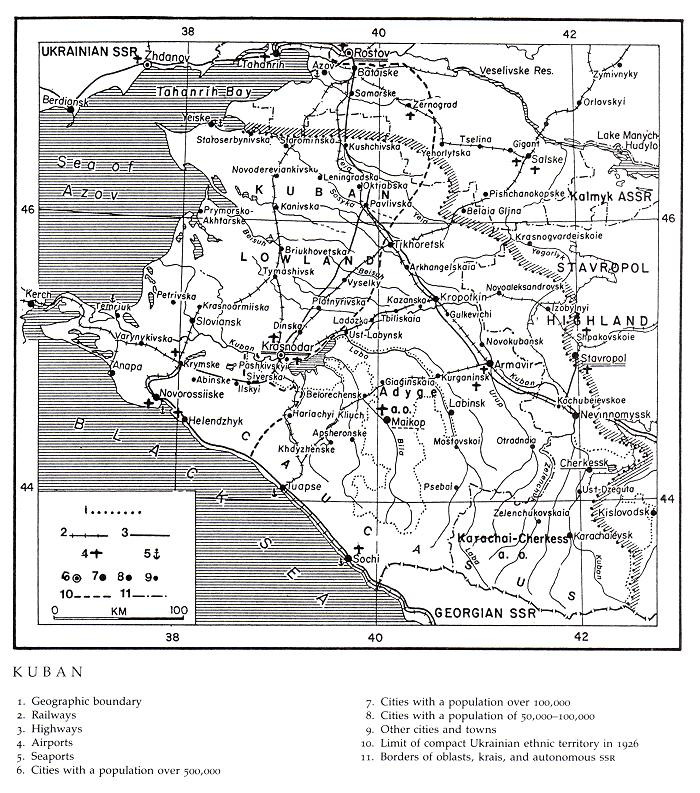
.jpg)
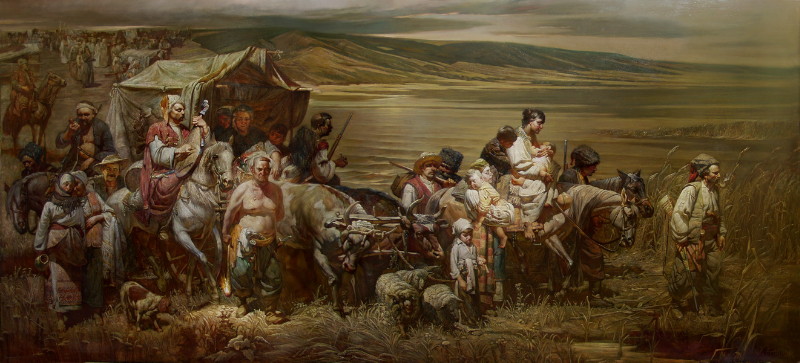
%20Kuban%20Ukrainian-style%20church%201868.jpg)
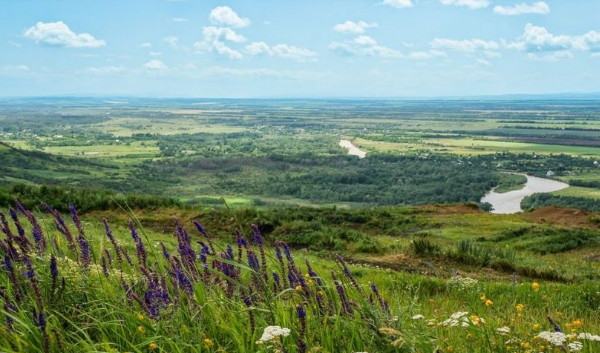
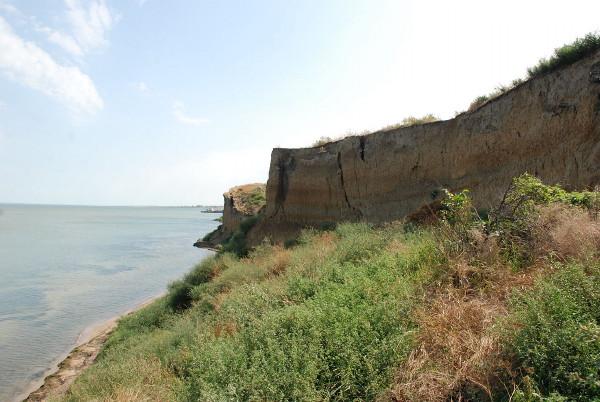
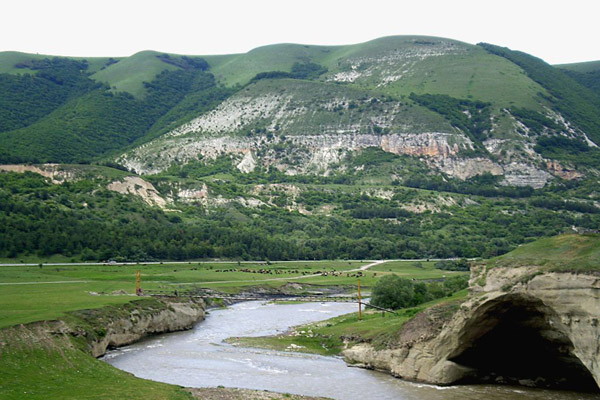
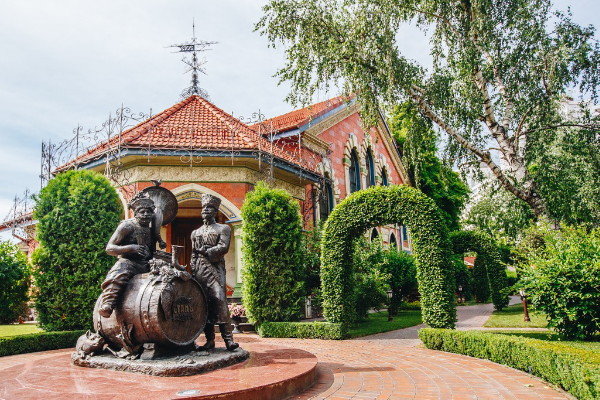
.jpg)
